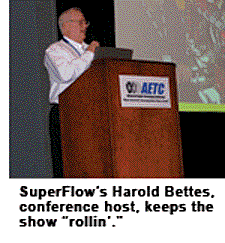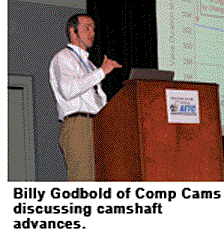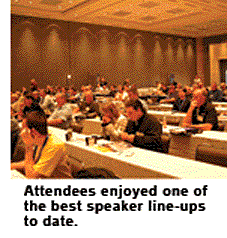The 17th Annual Advanced Engine Technology Conference (AETC) was held for the second year in a row at the Orlando Convention Center, Dec. 11-13, just days before the opening of PRI. While the weather wasn’t frightful, there wasn’t quite as much Florida sunshine as the previous year either, but the talk around each morning’s breakfast table wasn’t of the day’s forecast. This year’s conference proved to have one of the best speaker lineups to date.

For those who attend the AETC conference regularly, the atmosphere is sort of “old home week.” Many of the people in the room have known each other for a long time or are well known throughout the industry. But new faces and minds are always warmly welcomed as there are some very sharp minds on both sides of the stage, and the Q&A is always worthwhile.
From its inception, AETC has been the place to go to get the straight scoop on all the latest developments in the industry. The speakers are not typically marketing spokespeople simply spouting the company line. Many of the speakers are R&D experts, original developers of past and present state-of-the-art technologies and engine builders who are way ahead of the curve, as well as featuring success stories from those who started at the bottom and rose to the top. Their stories are all different but the common thread woven throughout the conference is passion – the one thing that drives everything in the industry forward, far beyond what was thought possible.
Jack Sparks of JE Pistons, said what drives the evolution of parts and how companies such as JE and Carillo continue to find ways to make parts and, ultimately, racers better, is having passion for what they do. Sparks worked in the family piston business until it was sold in the late ’60s and from there he went on to head up Carillo Rods and later took over JE Pistons when both companies were purchased by Dover Corporation (PMI). Sparks said the key to making parts is to “start out not to make a dollar but to make a part. It’s a business of passion and not many are formally trained to do this (industry).”
Sparks suspects that future advances in piston technology will likely come from using coatings and material surface conversions. Some piston materials, such as beryllium, have already been banned in certain racing applications so Sparks believes the way forward is essentially with better designs and attention to detail through such things as finite element analysis.
Ed VanDyne of Woodward explained that the SmartFire ignition system uses ionization technology for ignition and individual cylinder combustion feedback. The SmartFire technology allows for in-cylinder combustion feedback without having to drill holes in the heads for pressure sensors. This allows for highly reliable information feedback by utilizing the standard sparkplug as the conduit. The technology has been in use for many years and with various methods – some of which are in production cars today.
VanDyne said that race teams and engine builders can tune each individual cylinder and remove any variations between cylinders, which can in turn produce a 1 to 5 percent horsepower improvement by controlling individual cylinder fuel mapping, knock detection and control as well as individual cylinder spark timing. In fact, VanDyne noted that the Ferrari Formula One team has been using this system to reduce cylinder variations since the mid-1990s.
Following these two presentations was a short break for lunch and what SuperFlow’s Harold Bettes – who is AETC’s equivalent of a master of ceremony – describes as the best lunch and networking opportunity anywhere. During every meal, attendees and presenters mingle, discussing everything from speakers’ topics to politics to their favorite local watering hole. With people from all walks of the industry and the world, lunch conversations were never dull.

Ben Strader of EFI University went into the theory of relativity, Einstein and some other bits and pieces relevant to tuning an Electronic Fuel Injection system. As the founder and senior instructor of EFI University, Strader oversees all of the information that is taught in the school’s EFI-101 and EFI Advanced classes.
Strader led a discussion about properly identifying engine load in an EFI computer and how to accurately deal with altitude compensations. Strader primarily focused on what he calls the engine’s “Pressure Ratio.” This topic brought many questions from the audience about how to calculate the proper ratio and also on the use of lambda sensors.
Rick Roberts, PhD, of Edelbrock, spoke about Edlebrock’s development of a high output cylinder head for small block Ford drag racing applications. Roberts summarized the engineering effort behind Edelbrock’s new Glidden Victor SC-1 cylinder head including valve and spark plug layout, port configuration and flow studies, flow comparison with other racing heads, preliminary CFD results and their implications, and valve train stability and strength considerations.
Doug Schriefer, head of Technical Services at Barry Grant gave an excellent presentation on advanced carburetor tuning. Schriefer described his view as to what is necessary to obtain the last little bit of horsepower and reliability from a carburetor.
Schriefer explained how the carburetor operates off of the pressure differential, and said that his goal is to produce as much air velocity as possible to atomize the fuel better and improve engine performance over a wide range of conditions.
Andy Bloyce, PhD, of OC Oerlikon Balzers Coating AG, gave a presentation on the merits of High Performance Coatings for Motorsports applications. Dr. Bloyce explained the technology behind two of the newest and most extreme surface treatments used in racing. He said that Physical Vapor Deposition (PVD) and Plasma Assisted Chemical Deposition (PACVD) allow racing engines to be built with different materials and used in higher-pressure applications. Bloyce explained the uses and applications of these coatings as well as the wear and power advantages.

Billy Godbold of Competition Cams said that as we push the boundaries ever forward we must try to understand how subtle changes affect the entire system in order to evaluate the result, as is the case with designing camshafts. To that end, he discussed the effect of stiffness and mass on camshaft optimization. He said simply changing parts can be very misleading if you don’t understand what you are changing and why.
Greg Rodriguez, Engineering Manager, Screamin’ Eagle Perf-ormance Parts, Harley-Davidson, explained the step-by-step process of designing and the testing necessary to produce the 150-hp V-twin VRXSE drag bike engine. The engine uses technology common to car racing, such as titanium valves, NASCAR valve springs, metal matrix pushrods and more.

Jack Kane, founder of EPI, Inc., gave his presentation on Internal Engine Loads vs. Engine Life. Kane has been actively involved in piston engine development since the early ’50s and has configured, built and modified engines for a wide variety of specialized applications and race winning cars.
AETC wrapped up its conference roundtable-style, featuring all of the speakers answering questions from the audience about ANY topic.
For information about attending the 2007 Advanced Engine Technology Conference, visit www.aetconline.com.













